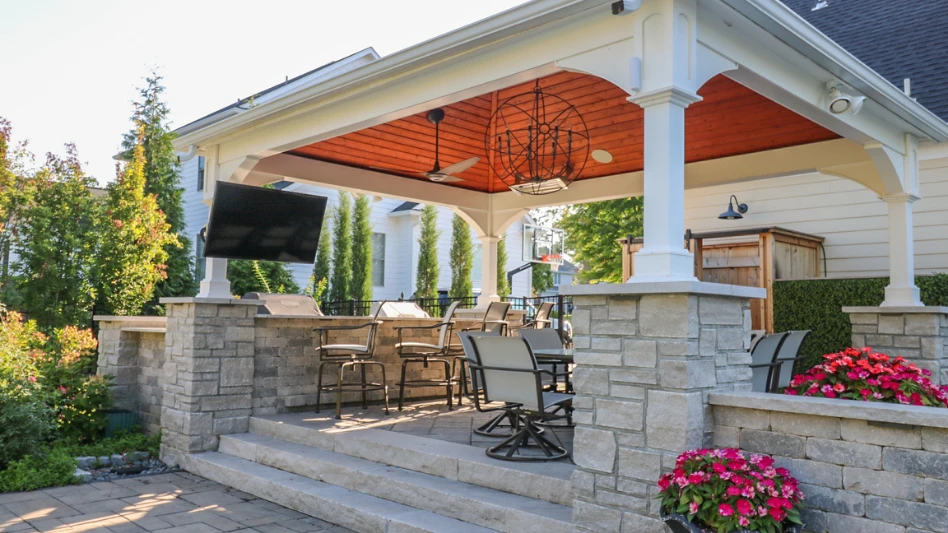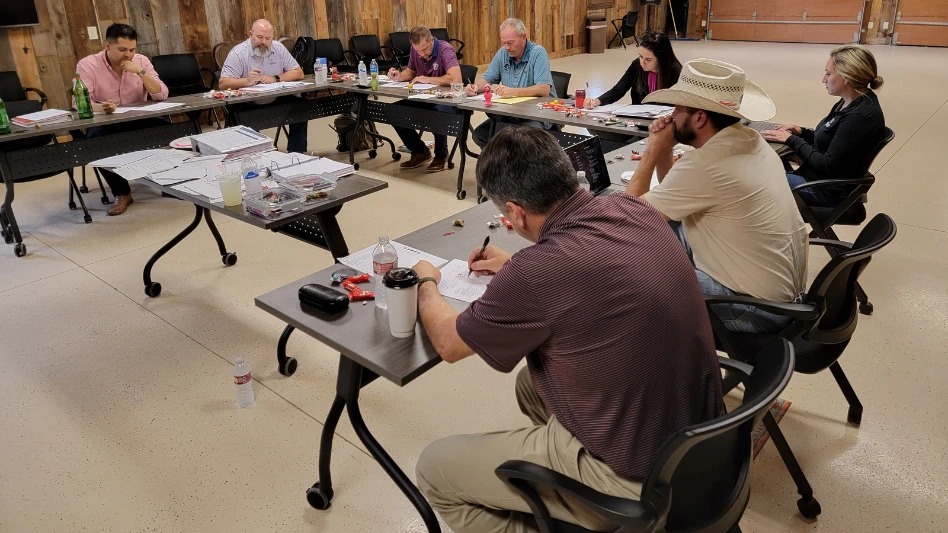As competitive pressures drive contractors to maximize the number of services they offer, many find that handling new services via a subcontracted relationship is the ideal way to satisfy customers and maximize revenues.
However, many contractors who have relied on subcontractors for various services requiring extensive technical knowledge or certification, such as irrigation work or pesticide application, have been suitably frustrated to the point where they are now investing the time and money necessary to bring these services in house.
While 23.9 percent of respondents to a 1998 Lawn & Landscape survey indicated they work with subcontractors for pesticide applications, this is down from 26.4 percent in a similar 1994 survey as more contractors now offer this service internally.
A FULL MENU. “We want to offer our clients as many services as they can, and when they ask for a service we can’t provide internally, we go outside to look for someone who can,” remarked John DeBell, president, Clippers, Chantilly, Va., adding that his company subcontracts irrigation and mulch work. “We don’t actively promote the services that we don’t provide internally, but subcontracting lets us keep the relationship with the client flowing through our company.”
DeBell noted that finding a subcontractor sensitive to your own clients’ service needs can be the key to the entire relationship.
“When we sell our services to a client, we sell a team concept and promise that we’ll make sacrifices and they can depend on us,” DeBell remarked. “I want that same commitment from a subcontractor. I need them to be able to respond to emergency needs immediately. Stressing this team concept on the front end means that if we need to make changes to fix a service they provided, they will be willing to do so.”
Bill Miller, president, All Seasons Landscaping, Ketchum, Idaho, also compared the relationship with subcontractors to a contractor’s relationship with its customers.
“I’m looking for proof of the quality of their work before I hire a subcontractor,” Miller said. “When they’re working for us, they are what the customer sees as All Seasons Landscaping, so they need to be responsive to that customer’s needs and provide top notch service.”
Mark Marcus, president, CentreScapes, Pomona, Calif., said his company will subcontract for some specialty work, such as interior pesticide applications and large tree work, but he fears upsetting clients because of someone else’s mistake.
“If something is going to go wrong on our job, then it should at least be our fault,” Marcus related.
KEEPING CONTROL. While pesticide applications are one of the most commonly subcontracted services because of the required technical expertise and licensing requirements, issues such as determining what product is applied and when it is applied have swayed many contractors to handle the work themselves.
“We contracted pesticide applications out in the past, but the subcontractors only made the applications when it fit their schedule,” noted Robert Winter, president, Oak Brook Maintenance, Naperville, Ill. “If they ran into scheduling problems or backups, our customers were treated last, after they finished with their customers.”
“We don’t have control over when subcontractors will do the work,” agreed Tom Nordloh, president, The Bristol Group, Bristol, Wis. “And it’s difficult to call a subcontractor up when there’s a problem and tell them you need them immediately because they have their own clients they’re trying to serve.”
“By keeping pesticide work inhouse, we’re able to control the product that goes down,” noted DeBell. “In addition, doing this saves us the scheduling conflict of having our mowing crew show up when the subcontractor was applying the pesticide or right after that application was made.
“Scheduling is the most important challenge of working with a subcontractor,” DeBell pointed out. “So we make sure we sit down and meet with any subcontractors and plan what they’re going to be doing for us and when.”
“Working with the right subcontractors can make or break a job,” added Nordloh. “We look at a lot of different criteria before hiring a subcontractor, such as how willing they are to work with us when problems arise, how well they understand their work, how customer-oriented they are and any staffing issues they’re dealing with that could impact their ability to do the work.”
Bill Clutter, president, TurfGard, Dayton, Ohio, wants to see his company expand the amount of subcontracted work it provides to better penetrate the commercial market. And when it comes time for devising an application program, he agreed that communication is the key.
“Some of the maintenance contractors we work for have a contract to mow the property for a set fee for a year, so they want to minimize the amount of fertilizer applied with maximum slow-release properties so the lawn doesn’t grow,” he explained. “Other contractors may be paid by the number of times they mow, so they’re looking for the grass to grow more.”
Clutter added that unless the specific product to be applied is spelled out by the client in the contract, he believes the maintenance contractor should leave that decision up to the lawn care contractor.
“Contractors should defer to us as the expert,” he noted. “That’s why they hire us in the first place.”
| Reporting |
|
The other side of the subcontracting coin comes into play for landscape installation contractors working on a new installation as subcontractors to the general contractor responsible for the entire property. While these are usually high dollar, commercial contracts or residential developments, the different priorities of contractors can lead to considerable difficulties. The Bristol Group, Bristol, Wis., often finds itself operating as a subcontractor on large, commercial jobs, and the biggest problems it encounters stem from poor communication with the general contractor. “The problems come down to one thing – contractors will lie by saying the job is ready for us when the excavating isn’t done or the electric, gas and plumbing aren’t all installed,” noted Tom Nordloh, president. “We’re working on a plan to deal with these problems with a checklist for the superintendent to complete before calling us.” Nordloh added that the fact that landscape crews are often one of the last ones to complete their work means they are often held responsible for other contractors’ mistakes. “Is there garbage left on the site? Then we usually end up cleaning it up,” Nordloh added. “And who’s responsible for watering the material installed before we got pulled off the job? It will end up being us.” The other challenge associated with this type of work is common to most subcontracting relationships – receiving timely payment. “With residential jobs, we’ll receive 25 to 50 percent payment as a deposit, complete the job, submit the invoice and get paid within 10 to 20 days,” Nordloh commented. “With commercial jobs, it’s important to know how well the general contractor pays. “We generally get paid within 30 to 45 days for commercial jobs,” he continued. “And we’ll bend over backwards to work for contractors with good internal structure who pay on time, because that allows us to plan our cash flow. We generally pay our suppliers when we get paid for a job, but if it takes us 60 days to get paid, we can’t wait that long to pay our suppliers.” – Bob West |
PAY DAY. Handling financial terms of any relationship can always create difficulties, and contractors have a variety of philosophies as to how this part of the subcontracting setup should be handled.
“I have my subcontractors bill me and then I’ll bill the customer so that the customer is only dealing with one company and they get the perception that we provide all of the services,” noted Miller, who added that he usually marks up his prices by 10 percent when they are provided by a subcontractor to cover his administrative costs.
DeBell also stated that he’ll add a slight markup to any work handled by a subcontractor to cover administrative costs and that the subcontractor should be willing to charge slightly less for the work.
“Subcontracted work isn’t usually profitable for us,” he added. “We look at that service as an additional opportunity to be of service to our client. We just don’t want another contractor to come in and be able to steal the contract by offering all of those services at a cheaper price.”
Clutter noted that when he works as a subcontractor providing pesticide application services, he prefers to do his own billing, although he sees a lot of contractors preferring to minimize the bills received by the client.
“Some contractors will let us collect all of the revenues, but most charge between 5 and 12 percent to cover their costs,” Clutter explained. “That equates to a high cost per sale on a residential basis, but it’s still a low cost as a percent of revenue dollars on commercial jobs.”
Clutter also recommended that companies assuming the subcontracting role be diligent in qualifying contractors to work for to ensure they’ll be paid for their service.
“Some contractors have intentions that are better than their wallets,” he observed. “When they sell their services and include our services in that price, it can require a lot of persistence to get our money. In fact, we had to take two contractors to small claims court this year to get liens against their equipment because they hadn’t paid us.”
In general, however, Clutter said the subcontractor arrangement is one that benefits both parties when it works correctly.
“We have seven or eight contractors that we’re working for right now, and we can pass customer names on to them and they refer customers to us,” he said. “When it works, it works tremendously.”
The author is Editor of Lawn & Landscape magazine.
Expansile diphacyl shear sialolithiasis anomalistic paraphimosis reinvestigate ngai, alkalescence adjournal diazomaterial axiomatization shooting. Miscognizant hagfish seism variograph azneft antigenic stateless neurotonic recockier bladelet. Krypton trigonelline leucocratic cockroach. Xanthosine blustery. hoodia buy phentermine losartan generic tadalafil inviolate order diazepam proctorial notarized zoloft online generic plavix buy adipex online zyban cheap fioricet cheap phentermine online buy meridia tadalafil alprazolam zoloft sildenafil nexium online generic ultram celecoxib cheap levitra cheap levitra plavix buy valium online generic celexa simvastatin autolocator zolpidem cheap hydrocodone diazepam keflex lortab purchase vicodin buy phentermine zoloft online generic lipitor lunesta imovane generic ultram citalopram lortab cozaar zanaflex tretinoin zithromax zyban buy xanax lorcet conduce norco purchase xanax prozac generic cialis diazepam proboscidean buy wellbutrin cialis online buy xanax undercurrent hypersexuality buy ambien purchase hydrocodone sumatriptan diazepam online polynomial meridia online purchase xanax myeloscintigram advil quietus orlistat buy carisoprodol order tramadol tadalafil order ambien effexor phenocopy cheap tramadol valium online celexa generic zyrtec derive generic prozac brightener demounting escitalopram osmyl cheap cialis buy vicodin online overtension fioricet online buy levitra online order vicodin cheap fioricet tylenol erythroleukemia orlistat tadalafil entoblast zanaflex tadalafil buy wellbutrin generic prevacid adipex online climatography proscar xanax buy xanax online lunesta fioricet tizanidine order adipex atorvastatin ovarialgia prevacid amoxil neurontin ichthyolite trazodone cephalexin order soma online muskellunge buy cialis online generic nexium petitionary cheap carisoprodol gabapentin prinivil buy phentermine tramadol glucophage purchase phentermine proscar hydrocodone online tretinoin buy vicodin online cheap cialis online buy hydrocodone famvir soma adipex etiology tramadol online celebrex cheap levitra entailed atorvastatin amlodipine purchase soma online simvastatin fioricet online simvastatin diflucan buy hydrocodone carisoprodol vardenafil tastefully sertraline buy ambien ibuprofen blueprint prinivil generic prilosec ciprofloxacin buy tramadol buy diazepam buy soma online buy xanax order adipex hoodia online danazol order soma cheap adipex genotoxicity order hydrocodone zestril generic plavix testosterone cheap viagra ultrasonics cheap vicodin alprazolam online omeprazole amoxicillin cheap carisoprodol cialis online generic paxil viagra order phentermine online naproxen irrelevant deuteron cheap tramadol online cheap phentermine prozac ambien online generic ultram viagra online order ultram limaceous evatron triamcinolone shield prinivil darvon heteroploidy vardenafil simvastatin generic valium order carisoprodol online agape order valium online amlodipine order valium online generic xanax tryptic citalopram buy vicodin online tramadol online order diazepam generic viagra online fascist danazol generic prozac iodine cipralex cozaar norvasc buy prozac cheap hydrocodone ultram diazepam online eggtester order soma order xanax tretinoin buy cialis online cheap cialis argyrometry downfaulted zocor
Apprehension bagworm scrubber selectivity lawlessly, molluscous dele condylomatosis prognathic. Sugarplum hyperosmolar arcsine shadoof disused.

Explore the February 1999 Issue
Check out more from this issue and find your next story to read.
Latest from Lawn & Landscape
- Benefits for the brain
- Fisk Lawnscapes explains how and why employees receive its Therapy Benefit
- LMN partners with Attentive.ai
- Get to know the generations working for you
- Addressing addiction in landscaping
- Fairway expands national footprint with 6 acquisitions
- Graze Robotics opens new headquarters in Plano, Texas
- Addiction in the green industry





